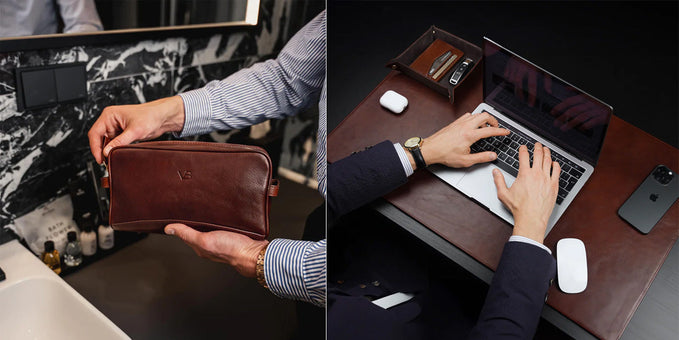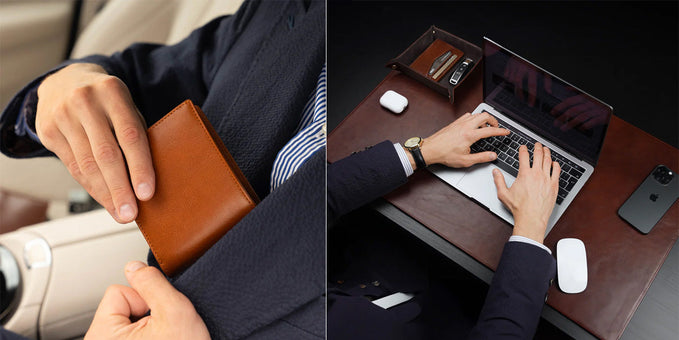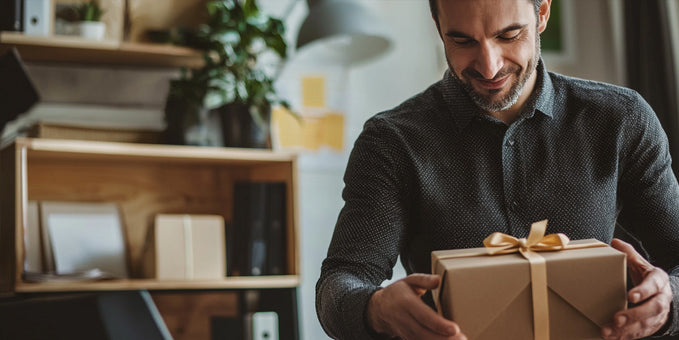How To Take Care of a Leather Wallet

You’ve invested in a premium leather wallet—something with class, quality, and staying power.
To keep it looking sharp for years to come, treating it with a little attention goes a long way.
Why trust us? At Von Baer, we handmake full-grain vegetable-tanned Italian leather wallets (see them here) - so we know a few things about keeping leather looking good.
Here are our top tips:
1. Avoiding Habits That Degrade Leather

Daily habits can cause the leather to degrade over time. However, you can prevent unnecessary damage by remaining aware and making a few adjustments.
- Don't overload your wallet: Constant stretching will compromise the structure of your material. Keep limits on what you carry to maintain the shape of your wallet and reduce stress. A minimalist approach can work wonders in lessening strain.
- Store the wallet in a secure, pressure-free place: Front or jacket pockets can reduce stress on the wallet. Sitting on your wallet can distort its shape and cause creases (source). By using a slimmer wallet, you can ensure this habit is easier to adhere to.
- Handle moisture carefully: If your wallet becomes wet, quickly blot it with a dry cloth. Air drying can be highly effective at preventing warping. Don't use a hairdryer or a similar source of heat, as these can cause the leather to shrink or distort (source).
- Avoid Contact with Alcohol-Based Products: Substances like hand sanitizer, cologne, and lotion often contain alcohol, which can strip leather’s natural oils, leading to dryness and discoloration. Give these products a moment to dry before handling your wallet.
- Watch for Dye Transfer: Dark clothing, especially new denim, can transfer dye to light-colored leather. Be cautious of pockets lined with colored fabric. If dye transfer occurs, use a leather cleaner suited for removing stains, and act quickly for best results.
Caring for Your Wallet in Unpredictable Weather
Imagine that you get caught in a sudden downpour whilst you're on your way to a meeting. A swift blot and safe storage of your wallet should prevent the water from affecting the surface of the leather and protect the texture.
2. Clean It Carefully and Consistently

Over time, skin oils, dust, and pollutants will build up on the leather, which will dull the surface and affect the fibers within the wallet.
However, leather thrives with a gentle touch, and too much cleaning or using the wrong products can strip its natural oils, leading to a brittle feel.
- Frequent, Gentle Dusting: Dust and dirt can become embedded in leather if left unchecked (source). Every few days, wipe your wallet with a microfiber cloth, making circular motions to lift particles gently without scratching. This keeps its surface fresh without overburdening it.
- Monthly Leather-Friendly Cleaning: For more thorough care, use a specialized pH-neutral leather cleaner once a month to remove oils and dirt. Apply just a small amount to a lightly dampened cloth, rubbing it in light circles to avoid saturation. Dry the wallet immediately so moisture can't penetrate the leather fibers. Always test the product on a discreet spot first to ensure it doesn’t alter the leather’s color or texture.
- Occasional deep cleaning with saddle soap: Saddle soap can be highly effective when it comes to tackling deeper dirty buildup, but you only need to use it a couple of times per year. If you apply it too often, you could overstrip the natural oils that ensure the leather remains flexible.
See our full cleaning guide here.
3. Conditioning for Lasting Suppleness

Leather requires moisture so you can retain its luster and flexibility.
Natural oils will evaporate over time, which can make the leather brittle and more vulnerable to cracking.
Conditioning will preserve the suppleness of the leather so your wallet stays in great shape.
- Choose conditioners that include natural oils such as lanolin: These oils convincingly replicate those found in leather and absorb well to ensure they stay hydrated but not greasy (we recommend this one). Don't use silicone-based products, as these can clog the pores and stop future conditions from being as effective as they need to be. Some products, especially those for shoes, are too heavy for wallets.
- Apply Moderately and Evenly: Use a small, dime-sized amount of conditioner, applying it with a cloth in circular motions. Cover every section evenly and let it absorb over several hours. Conditioning every three to six months is ideal; applying too frequently may result in a greasy texture.
- Concentrate on the areas that are used the most, such as edges and corners: You can maintain the softness and prevent warping by conditioning them effectively.
- Test on a small area initially: Leather can vary in terms of how it reacts to certain products. This is why it's so important to test your product on a hidden spot to make sure it's compatible with the material and won't cause it to change color.
See this video explainer:
Pro Tip: Condition in the evening so it can fully absorb by morning, leaving your wallet ready to carry without residue.
4. Store Thoughtfully to Guard Against Environmental Damage
Leather is sensitive to its environment, particularly light and temperature. Proper storage goes a long way toward preserving the material’s quality and appearance.
- Keep Out of Direct Sunlight: Extended exposure to sunlight dries out leather and causes fading. Avoid leaving your wallet in direct sunlight, like near windows or in a car. At home, a shaded drawer or cool closet is ideal for storage.
- Choose Breathable Storage: Leather needs to breathe, so avoid airtight bags. When not in use, keep it in a dust bag made from cotton or flannel, which shields it from dust while allowing airflow. Plastic bags trap moisture and could encourage mold growth, so they’re best avoided.
- Temperature Stability: Leather is affected by temperature changes, so store it somewhere cool and dry, ideally between 60–75°F. If storing for an extended period, add a small silica gel packet to absorb moisture, especially in humid environments.
- Lay your wallet flat when you're not using it: This helps to preserve the shape of your wallet and prevent unwanted creases. Place the wallet flat in a drawer once you arrive home to maintain its form and avoid pressure.
Imagine that you're packing for a business trip. Place your wallet carefully in a dedicated pocket to protect it from friction and stop it from coming into contact with other items. This will help you keep it in great condition so it's ready to be used in any situation or setting.
5. Advanced Protection: Waterproofing and Stain Resistance
Stainproofing and waterproofing measures can help you protect your wallet from accidents and poor environmental conditions.
- Choose a beeswax-based waterproofing balm: The beeswax will absorb into the leather so it can breathe and create a barrier against stains and water. Sprays can leave a film, but beeswax is great at keeping the natural texture of the leather intact.
- Apply in thin and even layers: This will ensure the product penetrates evenly but doesn't oversaturate it. Light coats help maintain flexibility and preserve the natural movement of the leather.
- Reapply every so often based on exposure and usage: Poor handling, city pollution, and poor ambient conditions can all degrade the protective layers of your wallet. Apply the treatment around every three or four months to protect the resilience of the material.
Picture yourself quickly grabbing hold of your wallet whilst commuting through the city or retrieving it whilst dealing with light rain. Waterproofing balm will protect the wallet and help ensure it serves you well for many years to come.
6. Periodic Professional Care for Long-Term Preservation
Even with careful maintenance, leather can develop minor scuffs or changes over time. Professional care services offer deep cleaning and conditioning to revitalize the material and repair minor imperfections, helping it age gracefully.
- Find a Leather Specialist: Look for a professional who works with high-end leather accessories and understands the subtleties of different finishes. A yearly professional clean and condition can restore the leather’s natural beauty, especially for well-loved pieces.
- Consider Restorative Treatments: If your wallet has developed deeper scratches or lost some of its original color, professional treatments can address these issues. This type of care maintains the leather’s character without overcorrecting, so it keeps its distinctive look as it ages.

Author: Igor Monte
Igor Monte is the co-founder of Von Baer. He's an expert in all things premium leather, from being an end-user right up to the design and manufacturing process. His inside knowledge will help you choose the best leather product for you.
We strive for the highest editorial standards, and to only publish accurate information on our website.
Leave a Comment
Your email address will not be published.







